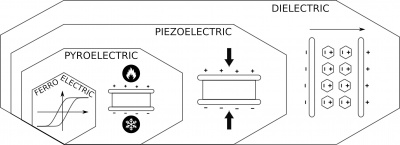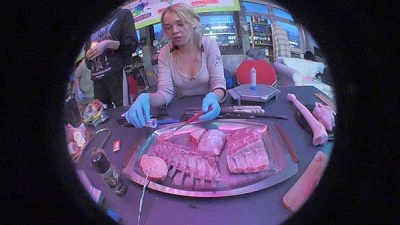Difference between revisions of "EnergyCrystals"
| Line 14: | Line 14: | ||
Much more interesting is piezoelectric effect, the next in the hierarchy. All piezoelectric materials are also dielectric materials (while not all dielectric materials are also piezoelectric). A piezoelectric material has a special internal charge distribution such that when a mechanical force or vibration is applied it generates a polarization. So when the piezoelectric crystal with two conducive surfaces is put under mechanical stress it generates and electric voltage. This effect is reversible, so when an electric voltage is applied the crystal may deform. <br> | Much more interesting is piezoelectric effect, the next in the hierarchy. All piezoelectric materials are also dielectric materials (while not all dielectric materials are also piezoelectric). A piezoelectric material has a special internal charge distribution such that when a mechanical force or vibration is applied it generates a polarization. So when the piezoelectric crystal with two conducive surfaces is put under mechanical stress it generates and electric voltage. This effect is reversible, so when an electric voltage is applied the crystal may deform. <br> | ||
| − | + | '' Pyroelectric Effect '' | |
It get's even more fancy with the pyroelectric effect where a change in temperature can create an electric charge. And again, every pyroelectric crystal is also piezoelectric and dielectric.<br> | It get's even more fancy with the pyroelectric effect where a change in temperature can create an electric charge. And again, every pyroelectric crystal is also piezoelectric and dielectric.<br> | ||
Revision as of 17:39, 5 December 2023
This page is to summarize our research in electro active crystal materials. There are many great instructions and descriptions online. The purpose of this summary is to give an overview of what we looked into and interesting insights we found. For detailed step by step instructions follow the links.
There are different electro active effects in crystal materials and those effects can be viewed in an onion hierarchy in some materials cumulate multiple effects.

Dielectric Effect
The most basic effect is the dielectric effect. When an electric field is applied by placing electrodes on two surfaces of crystals and applying an electric voltage, the crystal polarizes (dielectric polarisation). This means, while the crystals are electrically isolating materials and no current can flow through, in dielectric materials, charges can still shift slightly towards the poles.
What is this good for? Don't know, it's just the effect highest in hierarchy.
Piezoelectric Effect
Much more interesting is piezoelectric effect, the next in the hierarchy. All piezoelectric materials are also dielectric materials (while not all dielectric materials are also piezoelectric). A piezoelectric material has a special internal charge distribution such that when a mechanical force or vibration is applied it generates a polarization. So when the piezoelectric crystal with two conducive surfaces is put under mechanical stress it generates and electric voltage. This effect is reversible, so when an electric voltage is applied the crystal may deform.
Pyroelectric Effect
It get's even more fancy with the pyroelectric effect where a change in temperature can create an electric charge. And again, every pyroelectric crystal is also piezoelectric and dielectric.
We have not gone into this effect much yet.
pyroelectricity and piezoelectricity
A pyroelectric material generates a temporary voltage upon heating or cooling.
A piezoelectric material generates a voltage under the application of mechanical stress.
Sir David Brewster used Rochelle salt to demonstrate pyroelectricity and piezoelectricity in 1824.
Pierre and Jacques Curie expanded upon Brewster’s experiments. They found that quartz and Rochelle salt display the strongest piezoelectricity, but cane sugar, topaz, and tourmaline also exhibit the effect.
Make Rochelle Salt Crystals
Sodium Potassium Tartrate Tetrahydrate Growing Potassium bitartrate
It’s easy to make Rochelle salt using two common kitchen ingredients. Rochelle salt is sodium potassium tartrate tetrahydrate or potassium sodium tetrahydrate (KNaC4H4O6·4H2O). Rochelle salt yields large piezoelectric crystals, used for science experiments and as transducers in microphones and gramophone pickups
You need washing soda (sodium carbonate), cream of tartar (potassium bitartrate or potassium hydrogen tartrate), and water. If you can get washing soda, great! Use it. Most people don’t have ready access to washing soda, but can get baking soda (sodium bicarbonate). All you need to do to convert baking soda into washing soda is apply gentle heat.
Potassium bitartrate has a low solubility in water. It crystallizes in wine casks during the fermentation of grape juice, and can precipitate out of wine in bottles.
Links: https://www.instructables.com/Make-Rochelle-Salt/ https://sciencenotes.org/how-to-make-rochelle-salt-sodium-potassium-tartrate-tetrahydrate/
